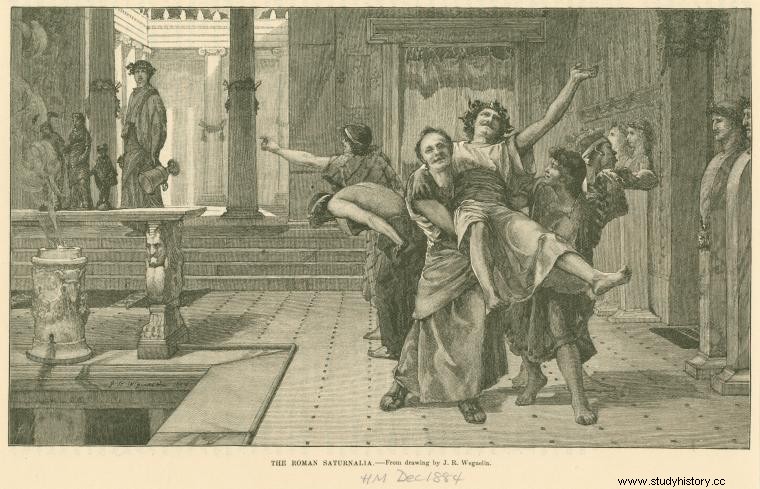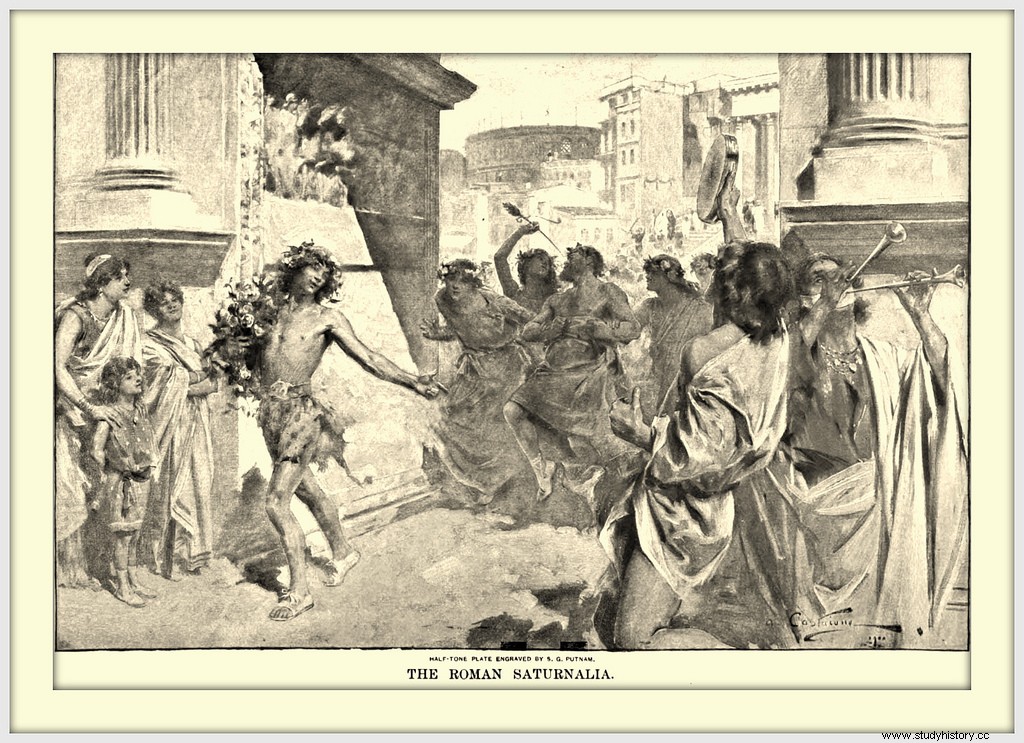The tenth month of the Roman calendar was, in terms of festivities, the most spectacular and lively of the entire year. In this month the idyllic golden age in which Saturn reigned over the rest of the divinities was commemorated. It was also the month in which the winter solstice occurred, a date marked as the birth of the solar gods. From the Kalendas (day 1) until the Ides (day 13) only the second Faunales should be highlighted (on the 5th) in commemoration of the god Faun and the Agonal, a ritual that consisted of sacrificing a ram to the Sun god (on the 11th) That same day the Septimontio was celebrated only in the City. , the seven hills, a minor festivity of the Latin towns that formed the archaic Rome.

On the 15th the second Ludii Consuales were held , in honor of the god of silos, Conso. The main rite consisted of celebrating mule races, similar to the "Tiro y Drag" that is still practiced in some rural towns of the Valencian Community.
The great moment of the month, I would even say of the year, came on the 17th. It was the day on which the Saturnalia began. , the great festivals in honor of Saturn. It was a festivity so appreciated by Roman civilization that, given the impossibility of concentrating so much activity in a single day, the festivities had to be extended until the 23rd. Most likely, the Saturnalia have their origin in the end of agricultural work, when the fields prepare for winter and the tasks of peasants and slaves slow down. Let us remember that the society of ancient Rome was eminently agrarian. How important would these festivities be for schools to close, some frivolous male and female conduct to be frowned upon, dice to be played in public, the roles of masters and slaves to be reversed, wine to flow in torrents, and all members of the the family received a gift, whatever their status. In addition, all slaves received generous extra pay in coin or wine from their masters (except for the poor wretches who had the misfortune to serve the filthy Marcus Porcius Cato).
From the 17th to the 23rd, banquets and wild processions took place (which were the embryo for future carnivals). The plebeians and proletarians set themselves up as judges, and the patricians as serfs. The election of the "King of Teasing" was held and, finally, after so many days of jubilation, the winter solstice arrived, consecrated to Janus, the god of principles, a date considered in ancient times as the Gate of the Gods. .

This chain of commemorations concluded on the 25th. In Asia this date was known as the "Day of the Unconquered Sun". It was a minor festivity until the emperor Aurelian , in the year 274, used it to relaunch the damaged imperial cult, proclaiming himself representative of the "divine light". Interestingly, Mithra , the Persian god of the sky and light who adopted half the Roman army as his own, was born on this very day… what a coincidence… as did the prince Shirdarta (better known to us as Buddha) and also the god Dionysus . What is the reason for this "coincidence"? Like almost everything, it has an explanation:in the year 325 the Council of Nicaea took place. (today Iznik, Turkey), the first Christian ecclesiastical meeting after the great persecution of Diocletian called by Emperor Constantine to order the religious currents that convulsed the new faith just tolerated. It was in this council where the bishops gathered there decided to place the imprecise birth of Jesus on this date of December 25, dispatching with this movement the annoying Mithra and the imperial incarnation of the "Divine Light"
In my opinion, and do not offend the most devout Christian believers at face value in the sacred texts, it is very difficult to understand that two thousand years ago a man in his fifties with his young wife almost nine months pregnant dared to cross alone and on a donkey the dangerous steppes of Samaria, and more so in winter. In addition, the imperial registration edict would take place, like others that we know of Roman jurisprudence, in early spring, so it is more logical to think that the son of Mary and Joseph was born after its diffusion in Judea, between March and April. . Now, that each one believes in what he wants, that's what freedom of belief is for.
On the 26th, a festival of Hellenic origin was celebrated, the Háloa . Fertility was dedicated, represented by Ceres , and only women participated in it, who were uninhibited in a mischievous procession displaying phallic symbols and lesbian attitudes.
The 31st was the eve of the Strenas . Enormous bonfires and street noise accompanied the last night of the year... We'll see in Januarius what those curious festivities in honor of the goddess Strenia consisted of. .
Collaboration of Gabriel Castelló author of Bravery .
